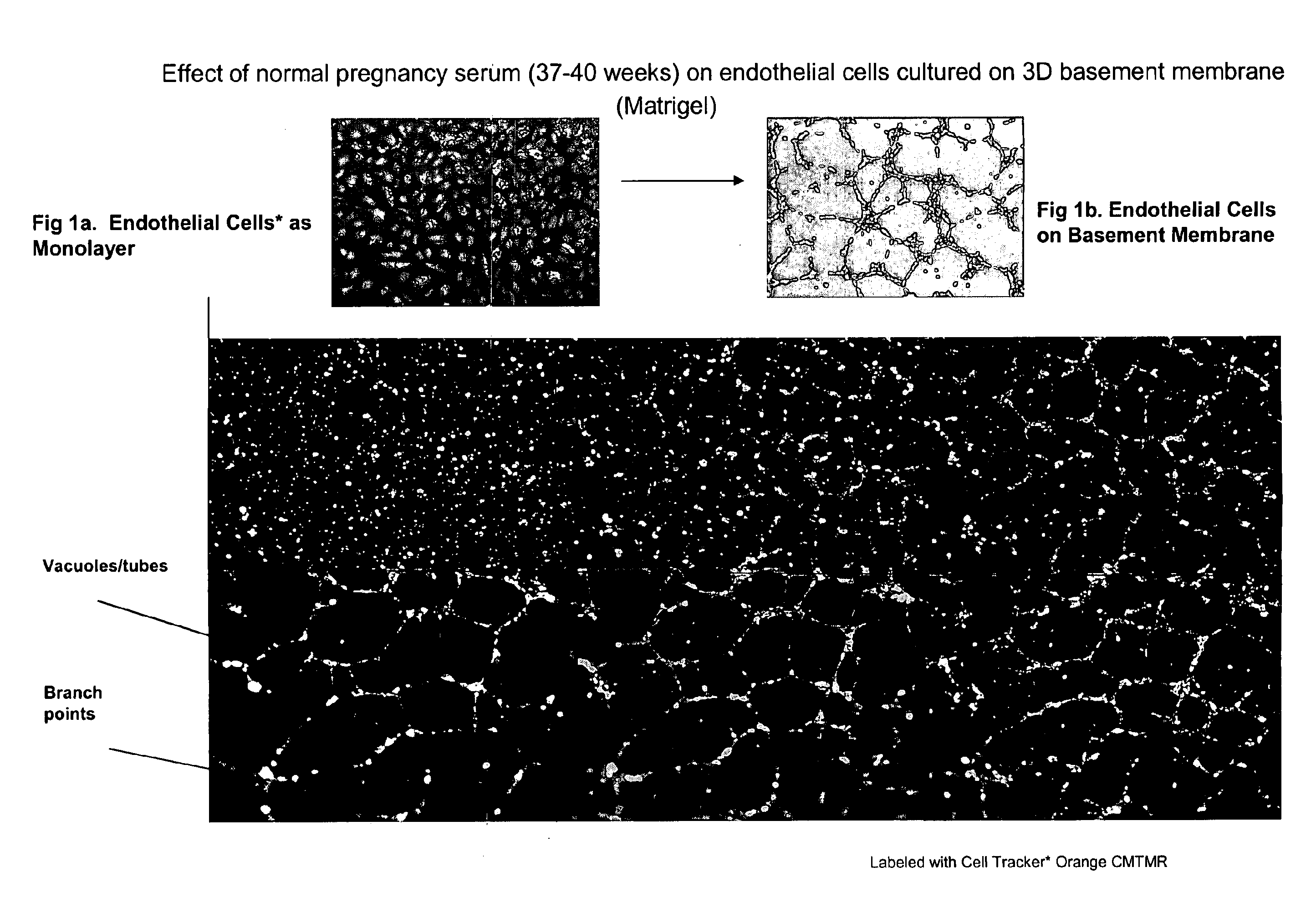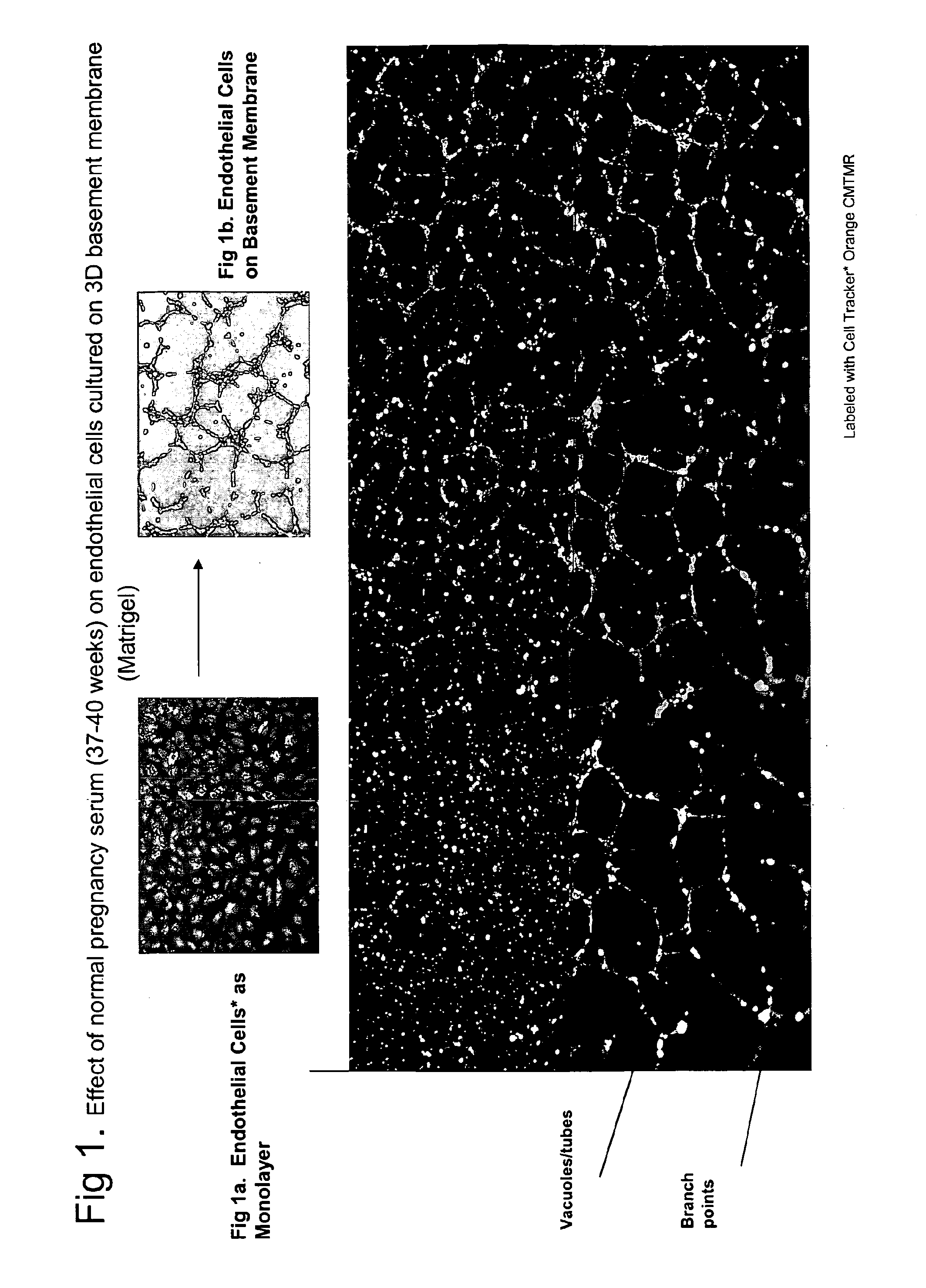Serum-based, diagnostic, biological assay to predict pregnancy disorders
- Summary
- Abstract
- Description
- Claims
- Application Information
AI Technical Summary
Benefits of technology
Problems solved by technology
Method used
Image
Examples
example 1
Effect of Normal Pregnancy Serum (NPS, 37-40 weeks) on Endothelial Cells
[0038]Human umbilical cord endothelial cells (HUVEC) and human uterine endothelial cells (HUtEC) were obtained from Cambrex (East Rutherford, N.J., USA). Growth factor-reduced Matrigel representing basement membrane (BD Biosciences, San Diego, Calif., USA) was thawed overnight at 4° C. and mixed to homogeneity. The 48-well culture plates (Costar) were coated with 0.1 ml of Matrigel and allowed to gelatinize at 37° C. for 30 min. 2.5×104 endothelial cells (HUtEC or HUVEC) labeled with cell tracker orange CMTMR (Molecular Probes, Eugene, Oreg.) were plated (1:1) in the presence of RPMI media containing 10% human pregnancy serum on the matrigel-coated plates. The architectural and morphological changes that took place were monitored and recorded 12-14 hrs after incubation under standard culture conditions using florescence microscopy (4× magnifications, Nikon Eclipse TS 100 coupled with CCD camera; photographs take...
example 2
Effect of Normal Pregnancy Serum on Trophoblast Cells
[0039]The first trimester human trophoblast cell line HTR8 (representing normal invasive extravillous trophoblasts), the third trimester human trophoblast cell line TCl-1, and the first trimester human villous trophoblast cell line 3A were used in the following studies. Human HTR-8 cells and TCl-1 cells were a gift from Dr. Charles Graham (Queens University, Canada) and human 3A cells r were a gift from Dr. Gil Mor, Yale University, USA.
[0040]Cytotrophoblasts from human placental tissue were isolated according to published methods. Briefly, placental tissues were digested with decreasing concentrations of trypsin-DNase 1 (trypsin, 1 mg / ml; and DNase, 1.5 mg / ml) at least four times at 37° C. for 20 min each. The cells from the first digestion were excluded. The cell mass collected in the following steps was treated with a lysis buffer (0.15 M NH4Cl, 1 mM KHCO3, and 0.1 mM EDTA (pH 7.3) for 5 min at room temperature with constant sh...
example 3
NPS Supports Trimester-Specific Differential Interaction with Endothelial Cells
[0043]2.5×104 endothelial cells labeled red and trophoblasts from human subjects, each from different trimesters labeled green, were co-cultured on matrigel-coated plates and stimulated with Normal Pregnancy Serum (NPS) (sample L31, see Table 1) as described in Examples 1 and 2.
[0044]Gestational age specific architectural patterns were observed. As seen in FIG. 3, left panel (which is labeled “EC+HTR8+L31”), surprisingly only the first trimester HTR8 trophoblasts spontaneously interact and align with endothelial cell architecture. S3A cells, representing villous trophoblasts from first trimester, attract endothelial cells and form massive branch points that allow reduced vacuolization only around its vicinity. (See FIG. 3, middle panel, labeled “EC+3A+L31.”) In contrast, term trophoblasts and third trimester TCL-1 trophoblasts tend to naturally impede the capillary formation by endothelial cells. Smaller ...
PUM
| Property | Measurement | Unit |
|---|---|---|
| Temperature | aaaaa | aaaaa |
| Time | aaaaa | aaaaa |
| Volume | aaaaa | aaaaa |
Abstract
Description
Claims
Application Information
 Login to View More
Login to View More - R&D
- Intellectual Property
- Life Sciences
- Materials
- Tech Scout
- Unparalleled Data Quality
- Higher Quality Content
- 60% Fewer Hallucinations
Browse by: Latest US Patents, China's latest patents, Technical Efficacy Thesaurus, Application Domain, Technology Topic, Popular Technical Reports.
© 2025 PatSnap. All rights reserved.Legal|Privacy policy|Modern Slavery Act Transparency Statement|Sitemap|About US| Contact US: help@patsnap.com



